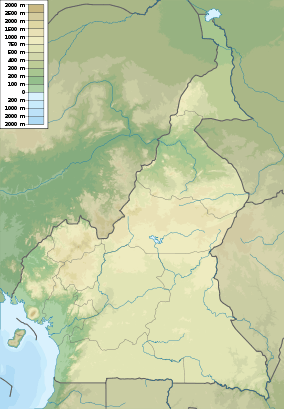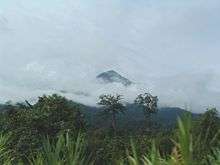Mount Cameroon
| Mount Cameroon | |
|---|---|
 Craters left after the eruptions in 2000 | |
| Highest point | |
| Elevation | 4,040 m (13,250 ft) [1] [2] |
| Prominence |
3,901 m (12,799 ft) [3] Ranked 31st |
| Isolation | 2,338 kilometres (1,453 mi) |
| Listing |
Country high point Ultra |
| Coordinates | 4°13′00″N 9°10′21″E / 4.21667°N 9.17250°ECoordinates: 4°13′00″N 9°10′21″E / 4.21667°N 9.17250°E |
| Geography | |
 Mount Cameroon Cameroon | |
| Location | Southwest Province, Cameroon |
| Geology | |
| Mountain type | Stratovolcano |
| Last eruption | May to September 2000 |
| Climbing | |
| First ascent | Joseph Merrick, 1840s[4] |
| Easiest route | Scramble |
Mount Cameroon is an active volcano in Cameroon near the Gulf of Guinea. Mount Cameroon is also known as Cameroon Mountain or Fako (the name of the higher of its two peaks) or by its native name Mongo ma Ndemi ("Mountain of Greatness"). It is the highest point in sub-Saharan western and central Africa,[5] the fourth most prominent peak in Africa and the 31st most prominent in the world.
The mountain is part of the area of volcanic activity known as the Cameroon Volcanic Line, which also includes Lake Nyos, the site of a disaster in 1986. The most recent eruption occurred on February 3, 2012.
Description
Mount Cameroon is one of Africa's largest volcanoes, rising to 4,040 metres (13,255 ft) above the coast of west Cameroon. It rises from the coast through tropical rainforest to a bare summit which is cold, windy, and occasionally dusted with snow. The massive steep-sided volcano of dominantly basaltic-to-trachybasaltic composition forms a volcanic horst constructed above a basement of Precambrian metamorphic rocks covered with Cretaceous to Quaternary sediments. More than 100 small cinder cones, often fissure-controlled parallel to the long axis of the massive 1,400-cubic-kilometre (336 cu mi) volcano, occur on the flanks and surrounding lowlands. A large satellitic peak, Etinde (also known as Little Mount Cameroon), is located on the southern flank near the coast. Mount Cameroon has the most frequent eruptions of any West African volcano. The first written account of volcanic activity could be the one from the Carthaginian Hanno the Navigator, who might have observed the mountain in the 5th century BC. Moderate explosive and effusive eruptions have occurred throughout history from both summit and flank vents. A 1922 eruption on the southwestern flank produced a lava flow that reached the Atlantic coast, and a lava flow from a 1999 south-flank eruption stopped only 200 m (660 ft) from the sea, cutting the coastal highway.
Access
The peak is frequently ascended by hikers. The annual Mount Cameroon Race of Hope scales the peak in around 4½ hours. Sarah Etonge, who has won the race seven times and is also a tour operator, has become known as queen of the mountain.
English explorer Mary Kingsley, one of the first Europeans to scale the mountain, recounts her expedition in her 1897 memoir Travels in West Africa.
Impatiens etindensis[6] and I. grandisepala[7] are plant species known only from Mount Cameroon. There are no trees in this area.
Gallery
 Relief Map
Relief Map A view of Little Mount Cameroon from the road of Limbe.
A view of Little Mount Cameroon from the road of Limbe. A lava flow of Mount Cameroon (1999)
A lava flow of Mount Cameroon (1999) This Sign is no longer at the top
This Sign is no longer at the top View from Limbe to Mt. Cameroon (Fako) and Mt. Etinde [M]
View from Limbe to Mt. Cameroon (Fako) and Mt. Etinde [M]
See also
Notes
- ↑ A higher elevation of 4,095 m (13,435 ft) is often given, but this is not compatible with SRTM data, which shows no 3" cells higher than 4,027 m (13,212 ft) or 1" cells higher than 4,029 m (13,219 ft).
- ↑ A hand held GPS reading of 4,045 m (13,271 ft) was reported in 2015. The elevation is subject to change due to volcanic activity.
- ↑ "Mont Cameroun, Cameroon" Peakbagger.com. Retrieved 2012-09-30.
- ↑ DeLancey and DeLancey 174. The authors do not give a precise year, but Merrick was active in Cameroon from 1844 to 1849.
- ↑ http://www.britannica.com/EBchecked/topic/90979/Mount-Cameroon
- ↑ Cheek, M. and S. Cable. 2000. Impatiens etindensis. In: IUCN 2013. IUCN Red List of Threatened Species. Version 2013.1. Downloaded on 03 July 2013.
- ↑ Cheek, M. and S. Cable. 2000. Impatiens grandisepala. In: IUCN 2013. IUCN Red List of Threatened Species. Version 2013.1. Downloaded on 03 July 2013.
References
- DeLancey, M. W. and M. D. DeLancey. (2000). Historical Dictionary of the Republic of Cameroon (3rd ed.). Lanham, Maryland: The Scarecrow Press.
- "Cameroon". Global Volcanism Program. Smithsonian Institution. Retrieved 2009-01-14.